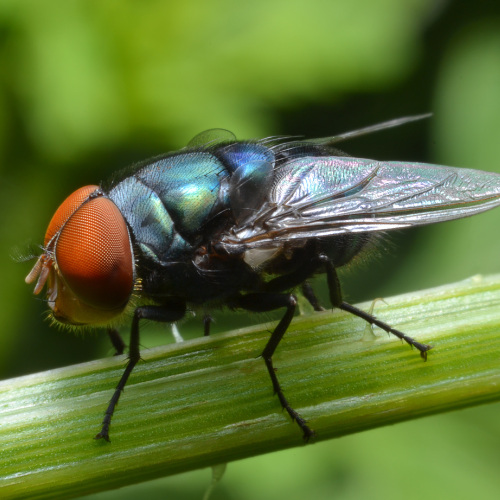Blow Fly

Proud Supporter of Disabled Veterans
No Contracts
Services provided without written contracts.
Introduction to
Blow flies, belonging to the family Calliphoridae, are well-known for their metallic sheen and their role in the decomposition process. These flies are often found near decaying organic matter, where they lay their eggs. While they play a crucial role in the ecosystem, helping to break down dead animals and organic waste, blow flies can become significant pests when they invade homes or infest food sources. Understanding their biology, habits, and effective prevention methods is essential for managing blow fly infestations and maintaining a hygienic environment.
Recognition
Blow flies are medium to large-sized flies, typically measuring 1/4 to 1/2 inch (6-12 mm) in length. They are easily recognized by their metallic blue, green, or bronze coloration. Blow flies have large, reddish-brown compound eyes and clear wings. Their bodies are robust and slightly hairy, and their antennae are short and three-segmented. Blow flies can be distinguished from other flies by their metallic sheen and their attraction to decaying organic matter. They are often confused with house flies, but blow flies are generally larger and more vividly colored.
Biology
Blow flies undergo complete metamorphosis, progressing through four life stages: egg, larva, pupa, and adult. Females lay clusters of eggs on decaying organic matter, such as animal carcasses, garbage, or feces. The eggs hatch into larvae, commonly known as maggots, within a day. The larvae feed on the decomposing material, growing rapidly and molting several times. After feeding for a few days to a week, the larvae move to a drier area to pupate. The pupal stage lasts about a week, after which adult flies emerge. The entire lifecycle can be completed in as little as two to three weeks, allowing for rapid population growth.
Habits
Blow flies are typically found in areas where decaying organic matter is present. They are common in garbage dumps, compost piles, and near animal carcasses. Blow flies are strong fliers and can travel long distances in search of food and breeding sites. They are attracted to the smell of decay and are often among the first insects to arrive at a decomposing body. Blow flies play an essential role in breaking down dead organic material but can become pests when they infest homes, particularly if there is a source of decay indoors. They can also contaminate food and surfaces with bacteria.
Prevention
Preventing blow fly infestations involves maintaining good sanitation and promptly removing sources of decaying organic matter. Ensure that garbage is properly sealed and disposed of regularly. Clean up pet waste and outdoor areas where animals may have died. Use screens on windows and doors to prevent flies from entering the home. Regularly inspect and clean trash bins, compost piles, and other areas where organic matter accumulates. Properly store food to prevent contamination. If an animal dies in or around your home, promptly remove and dispose of the carcass to prevent fly breeding.
Professional
If blow flies become a persistent problem, professional pest control services can provide effective solutions. STL Pest Control offers comprehensive treatments to eliminate blow fly populations from homes and commercial establishments. Their technicians are trained to identify breeding sites and apply appropriate treatments, including insecticidal sprays, baits, and integrated pest management techniques. In severe cases, they may recommend ongoing maintenance plans to keep blow fly populations under control. Professional services ensure thorough and long-lasting control, providing peace of mind and a cleaner living environment.



Our Office







